Bladder snails can be good or bad, depending on whether you intentionally introduced them to your aquarium. These snails are active waste and algae eaters, which makes them an excellent option for low-maintenance waste management.
You can physically introduce them to your tank to do the job, but most aquarists do not get bladder snails in their system in this manner. Aquarists unintentionally get bladder snails when they introduce live plants with bladder snails latching on the leaves.
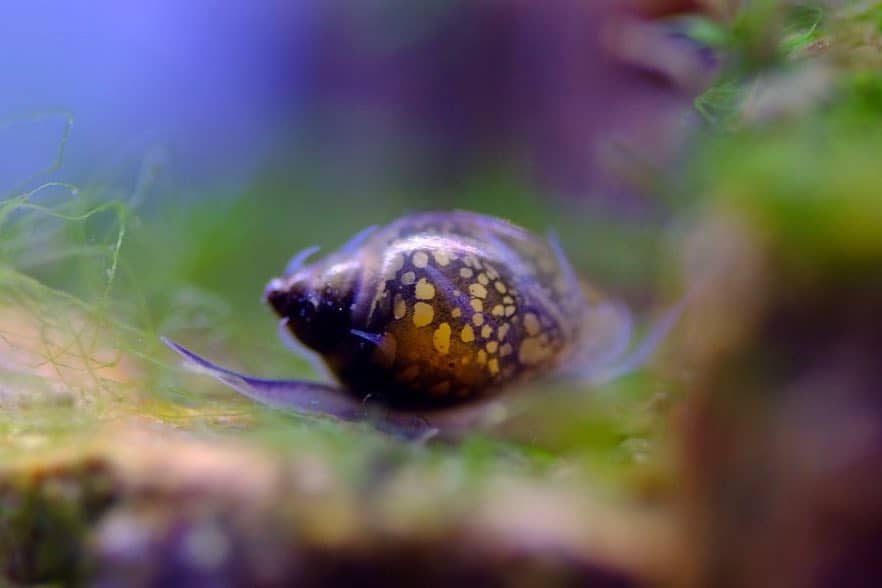
At first, the bladder snails are a blessing, actively eating decaying matter, waste, and algae at the surface. However, the problems begin when the snails start reproducing. Bladder snails do not need a mate of the opposite sex to breed, meaning they can easily take over the tank in a matter of weeks if you do not get them out.
With this in mind, it is important to know all about bladder snails, from how they breed to how they behave and how they are cared for. Read on to know exactly what to do about bladder snails.
Bladder Snail Overview

| Names | Bladder Snail (Physella acuta)
Also known as the European physa, the acute bladder snail, or tadpole snail |
| Origins and Reginal Distribution | Common in many parts of the world, from North America to Europe, Arctic Zones, and the North Temperate
First noticed in the Mediterranean during the 19th Century as part of the Lymnaeoidea superfamily of mollusks. |
| Water Hardness Conditions | 12 to 18 kH
8 to 18 gH |
| Lighting Conditions | Moderate with no direct bright sunlight |
| Average Size | 0.5 inch to 0.6 inches |
| Colors | Translucent/Transparent yellowish shell |
| Lifespan | 1 – 2 years, about 3-5 years in the ideal environment |
| Food | Algae, dead leaves, and small leafy vegetation |
| Breeding | Freshwater conditions with 12 degrees of hardness |
| Optimal pH levels | 7.0 – 8.0 |
| Optimal Temperature | 68 – 84 degrees Fahrenheit |
Short Summary of Bladder Snails and their habitats
The bladder snail scientifically belongs to the Gastropoda class of the Physidae family. They come in two types, the Aplexa hypnorum, also called the moss bladder snail, or the Physella acuta, also called the acute bladder snail. Physella acuta is the most common type that is found all over the world and is most likely the one in your aquarium tank.
These snails live in warm temperature waters but are very tough, capable of surviving the harshest of climates, from cold water to polluted environments and infested waters. Finding bladder snails in sewer water or contaminated rivers is not uncommon.
Bladder snails are also survival experts because of how they breed. These little critters are hermaphrodites with male and female reproductive systems. This means that they can reproduce in greater numbers than other snails like the Mystery or Nerite snails which require mating to lay & fertilize eggs for reproduction.
Many aquarists do not get bladder snails in their tank since they are harder to manage compared to other cleaning crew snails on the market. Their small size makes them harder to spot, which can be challenging when you want to eliminate them.
Even though bladder snails are harder to eliminate, they make great algae eaters because they are easier to care for. They do not require strict tank sizes like other snails used for cleaning, and their small sizes make them easier to feed.
Lifespan
Like most aquatic life, the bladder snail’s lifespan depends on the living environment. Bladder snails rarely live for more than two years. They are very persistent, and you will have them around for a long time if their breeding is not controlled.
In rare cases where the environment is ideal with all the perfect water quality, water parameters, temperature, and food, the bladder snails can survive for longer, for about three to five years. However, this is a rare case.
Appearance: Shape, Colors & Sizes
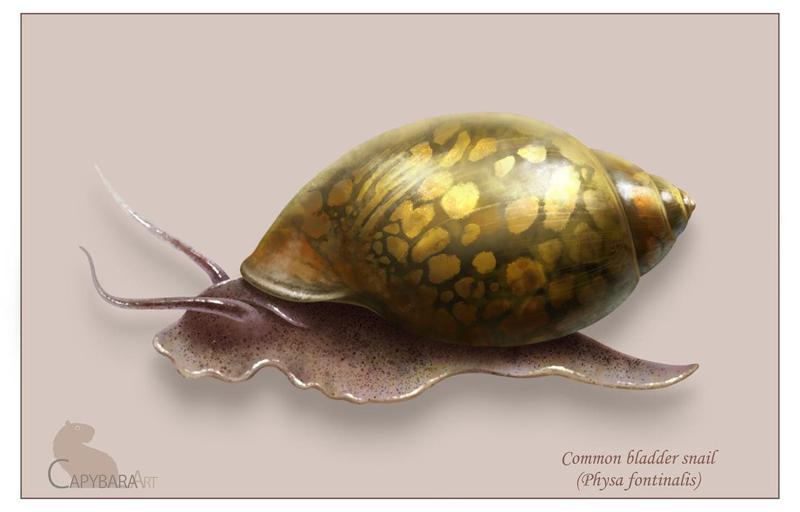
Bladder snails are very distinctive because of their shells.
The shells are sinistral, which means that the spirals on the shell are striped to the left instead of the right, as you will commonly see in other snails. This rare appearance makes them very easy to spot in a pond or aquarium filled with other snails like the common pond snails.
Another distinctive feature of bladder snails is the lack of an operculum. Most snails, including the popular mystery snail, have an operculum structure. The structure is located on the right side in front of the shell.
The operculum covers the shell’s opening, acting as a defensive structure that protects the fragile insides from predatory attacks or physical trauma.
Bladder snails do not have an operculum, making them an easy target for natural predators like crayfish, Yoyo loaches, betta fish, and the green spotted puffer.
Bladder snails also separate themselves from most snails with their translucent to transparent shells. Some describe the bladder snail’s color as grey or purple, but this is the color of the visible insides of the snail.
The uniquely (resembling the shape of an egg) shaped shells have little color but can be described as yellowish or of a similar tint like gold. You will also notice the mantle attached to the sinistral shell has yellowish to orange-like spots and/or stripes.
The bladder snail’s shell is longer than those of other snails, with a large aperture and a pointed spire. You would think that their large aperture would make them long, but bladder snails rarely grow bigger than 0.6 inches. The average size of a typical aquarium bladder snail is usually ½ an inch.
As for their eyes, the bladder snail has thin tentacles that hold up small black-spotted eyes. The eyes & tentacles are the only sensory organ of the bladder fish, but the tentacles do most of the job since the eyes aren’t that great.
Bladder Snail Behaviors
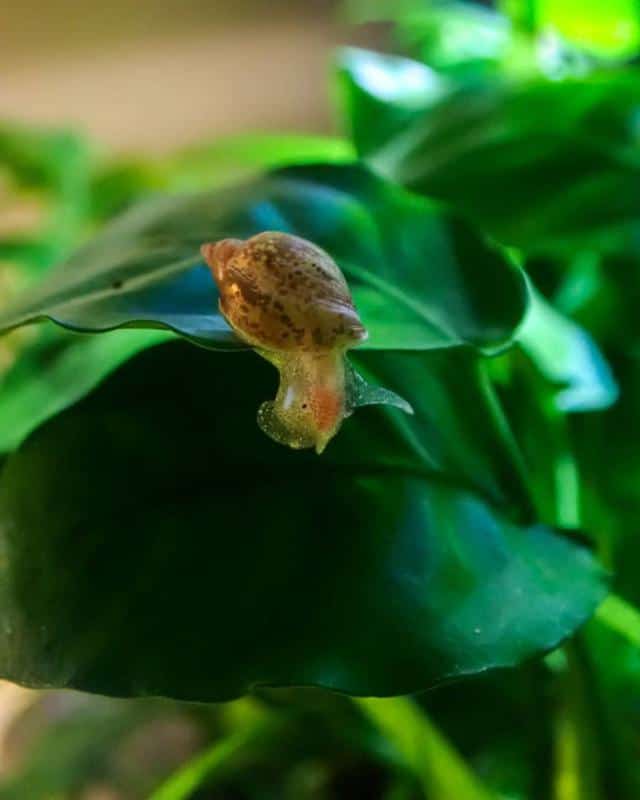
If you have seen bladder snails in an aquarium or pond, then you may have noticed their unique pulmonary snail behaviors – swimming, shaking, and bobbing.
Pulmonary snails are lunged aquatic snails that do not have an operculum, like our little bladder snails here. The lack of an operculum, however, grants them a lung-like structure called the pulmonary cavity (air bladder in some cases) that helps the bladder snail breathe in air from the water surface.
They are able to climb up to the top or sink to the bottom because of this respiratory system. Bladder snails take in air into the pulmonary cavity, which helps them float to the surface of the water or eliminate the air from their system to swim to the bottom of the tank.
This air bladder system also gives them the ability to shake their bodies in case other animals/organisms attach to them. In this regard, bladder snails rarely get parasitic attacks because they use their pulmonary cavity to shake their bodies and eliminate parasites, bugs, worms, or microorganisms.
Besides shaking their bodies to protect themselves, the bladder snails also use the air bladder for swimming quickly past predators. These snails cannot dig through the bottom dirt to hide; therefore, they rely on their ability to move at remarkable speeds to escape predators or any danger.
The acute bladder snails are active eaters and scavengers who spend most of their time ravaging through all the waste, algae, and decaying matter they can find in your tank. They move very quickly through the tank compared to other snails because of their pulmonary cavity, making them harder to spot.
Since they are small, they can easily escape your eye in a large tank that has lots of waste. They always eat at one spot for long periods until the food in that spot is gone.
Bladder snails are peaceful creatures like other snails, which means you will only see them move about when looking for food or running away from predatory species.
Breeding
Bladder snail breeding is very easy. There is no intervention needed on your part to ensure the bladder snail eggs hatch and give rise to the dazzling baby bladder snails.
You won’t need to perform snail acclimation, temperature changes, or water transfer. No quarantine is needed, and you do not need to purchase a male bladder snail to get baby bladder snails.
One frequently asked question is can bladder snails reproduce asexually?
Bladder snails are hermaphrodites, which means they can produce both asexually and sexually. Hermaphrodites are animals with both female and male reproductive systems. This means that one bladder snail can reproduce by fertilizing the eggs internally and laying the eggs that later hatch into baby snails.
It is important to remember that this is not the default way of producing bladder snails. The snails will not produce asexually without a mate unless their survival is threatened when a male mate is not available.
Baby bladder snails born through one parent are not fit to live longer or become strong enough to survive. In this regard, it is recommended to ensure you have a male and a female bladder snail when you are breeding them. Also, it is a good practice to cross-breed the snails with other bladder snails to keep their genes stronger.
Bladder Snail Care
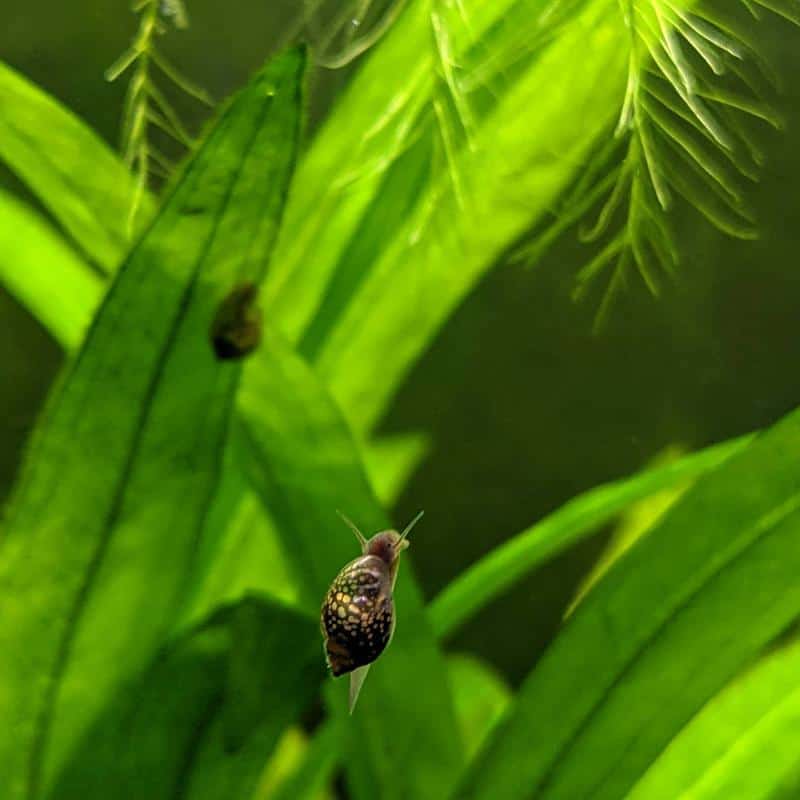
These are all the things you want to consider and keep in mind if you are planning on breeding or keeping the bladder snails in your tank:
Tank Size & Aquarium Environment
Bladder snails do not require any specific tank size to thrive because of their small sizes and the fact that they can grow to fruition in many hostile environments.
You may have a dirty tank and still have a thriving bladder snail colony. These tiny creatures survive on the barest minimum requirements and will not demand anything from you except an eye on the bio load.
The bio load is more manageable in a larger tank. Pick and choose according to your preference and needs but ensure you always get a bigger tank than your needs might require. Bigger is always better.
Bladder snails also don’t mind a tank with little to no live plants. They aren’t particular with hiding spots in the décor either since they are always eating.
Water Parameters
The ideal water conditions for a bladder snail include water temperatures between 64- and 84 degrees Fahrenheit, pH between 7 and 8, and fresh hardy water with 12 degrees of hardness.
But since bladder snails are tough and resilient, you can have a thriving colony in the worst of conditions, from colder waters to softer water and dirtier water quality.
Bladder Snail Diet
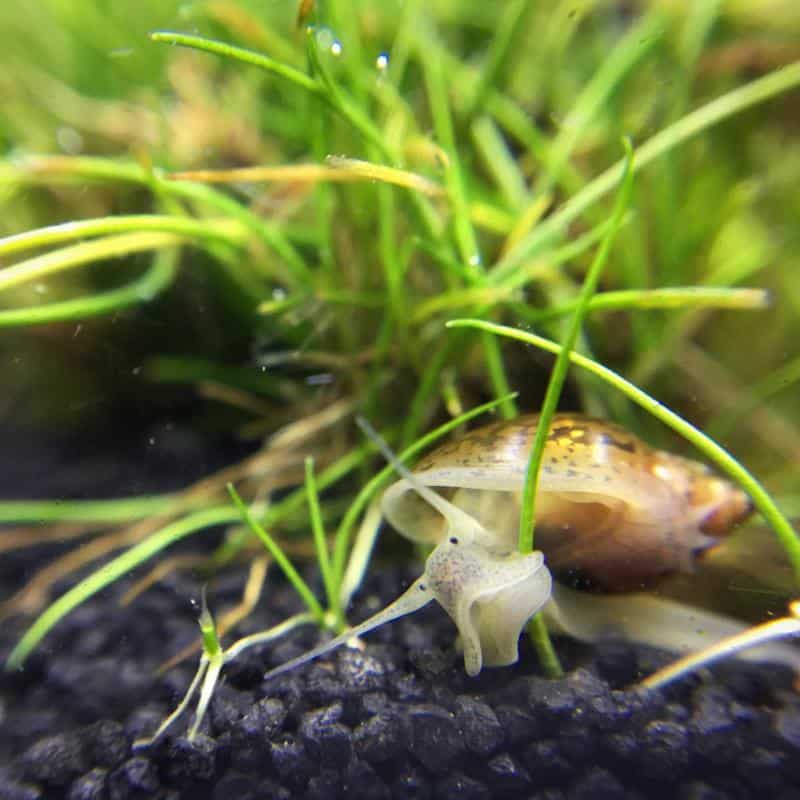
So, what do bladder snails eat?
Bladder snails are always eating. If they are not scavenging for food at the bottom of the water tank, then they are swimming to the top, feeding on other small organisms and decaying vegetation they can find on their way.
So, do bladder snails eat plants? You will never have to worry about your live aquatic plants with these snails. Bladder snails only feed on decaying dead vegetation and only nibble on live plants if they are bored or scavenging for more food.
Since they are omnivores, bladder snails also feed on the meat fish food you put in the tank. The snails can be a good solution to a tank that frequently suffers from overfeeding because they will snack on all the leftovers, from meats to vegetables.
Algae is their main source of food in an aquarium. Decaying vegetation and waste is their other most frequent diet, which means you will rarely have to worry about supplementing their diet with outside food.
The only consideration when it comes to outside food is their source of calcium. Bladder snails, like other snails, depend on calcium to have harder shells that extend their lifespan and make them more efficient.
Bladder snails require more calcium from birth since their baby bladder shells are softer and more fragile. It is important to ensure the water is filled with calcium-rich nutrients to keep the bladder snails healthy and growing (unless you want the opposite results to get rid of the snails, of course).
Read More:
- Best Aquarium Fish that Eat Snails
- Assassin Snail Care Guide
- Aquarium Snail Eggs: What to Do with Them?
Bladder Snail: FAQs
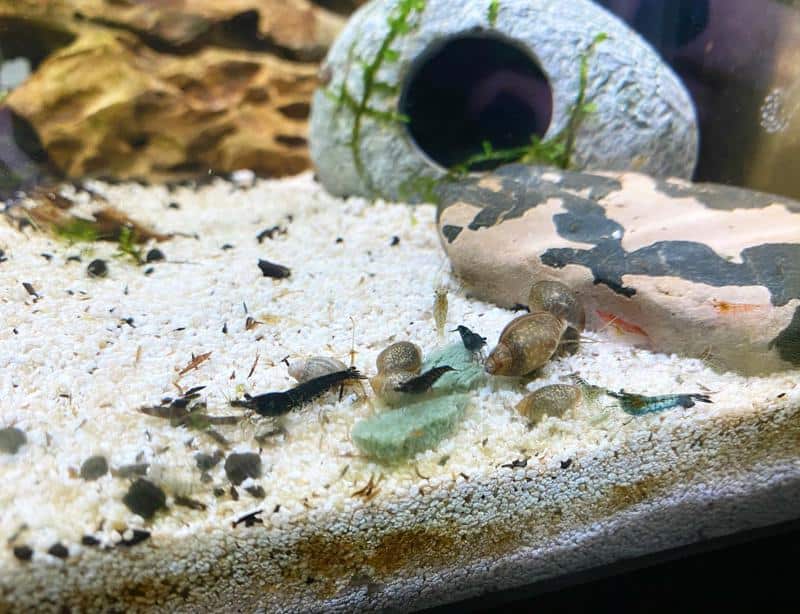
Pond Snail vs. Bladder Snail
The pond snails are easily mistaken for bladder snails by many aquarists since they live in similar environments, often together. Here are the three key differences between the pond snail vs. bladder snail:
- Pond snails are larger in size- Bladder snails grow up to 0.5 inches or 0.6 inches at best. Pond snails, on the other hand, are bigger and more noticeable, with an average size of 1 inch to about 3 inches at best.
- Pond snails have thicker tentacles – Bladder snails’ tentacles, on which the black-spotted eyes are mounted, are thinner with a thread-like resemblance. On the other hand, pond snails have thicker tentacles that are triangularly shaped.
- Pond snails do not have sinistral shells – Bladder snails are easily distinguished by their sinistral shells that spiral to the left. Pond snails have dextral shells that spiral to the right instead.
- Pond Snails’ antennas look like horns and Bladder Snails’ antennas look more like hair.
Should I Keep Bladder Snails?
You should only keep bladder snails if you have a big tank. This is because you cannot easily control their breeding rate, and it is only a matter of time before their numbers become uncontrollable.
A big tank will ensure you have more space to accommodate a larger number of bladder snails. It will also help you keep natural predators that can feed on the bladder snails to keep their numbers at bay. A good example of such fish is the crayfish and the betta fish.